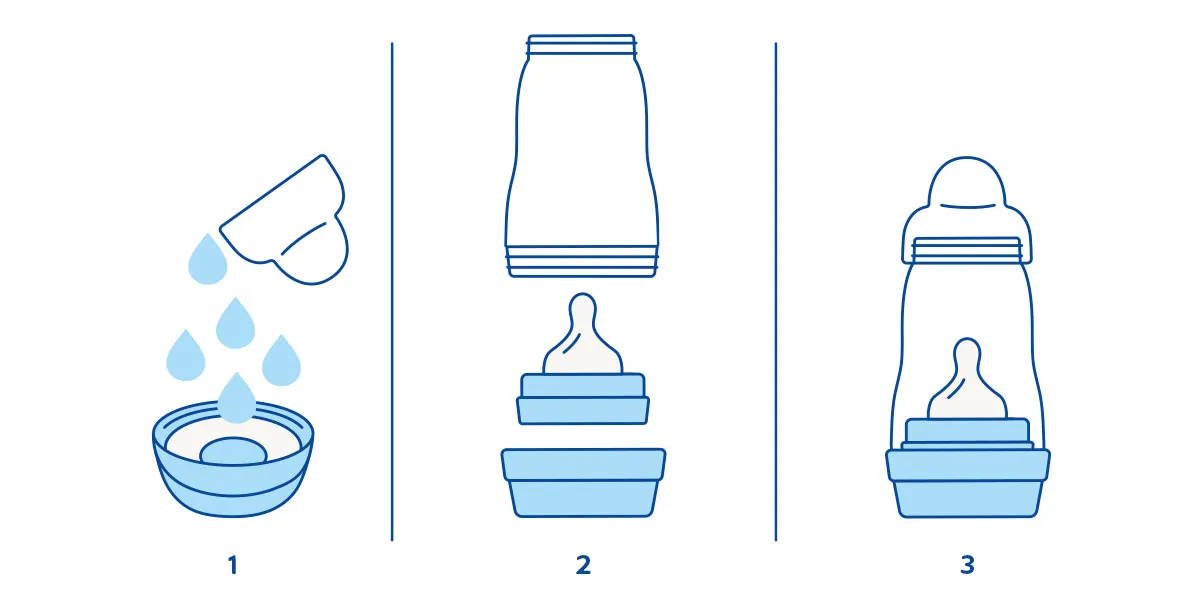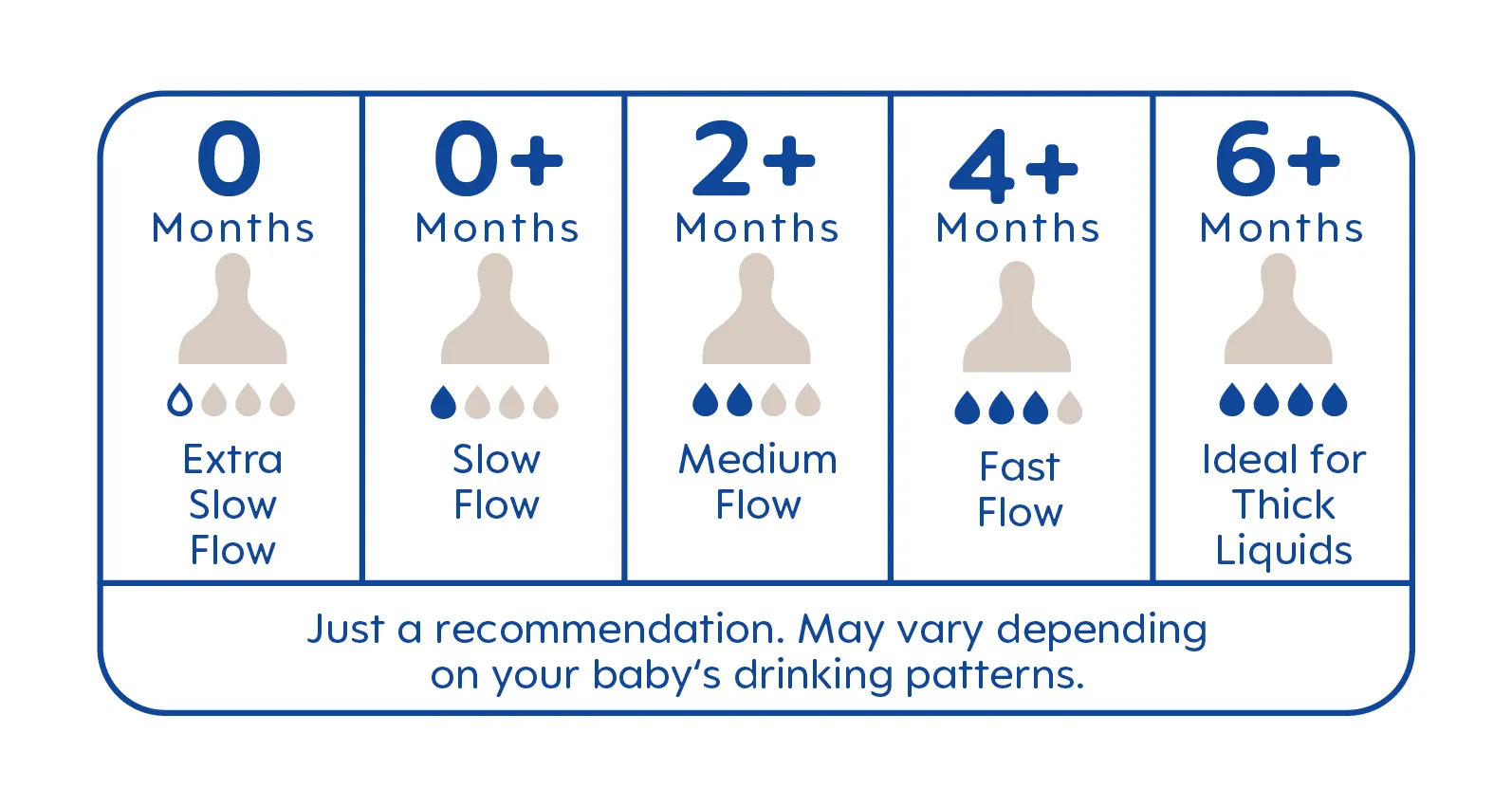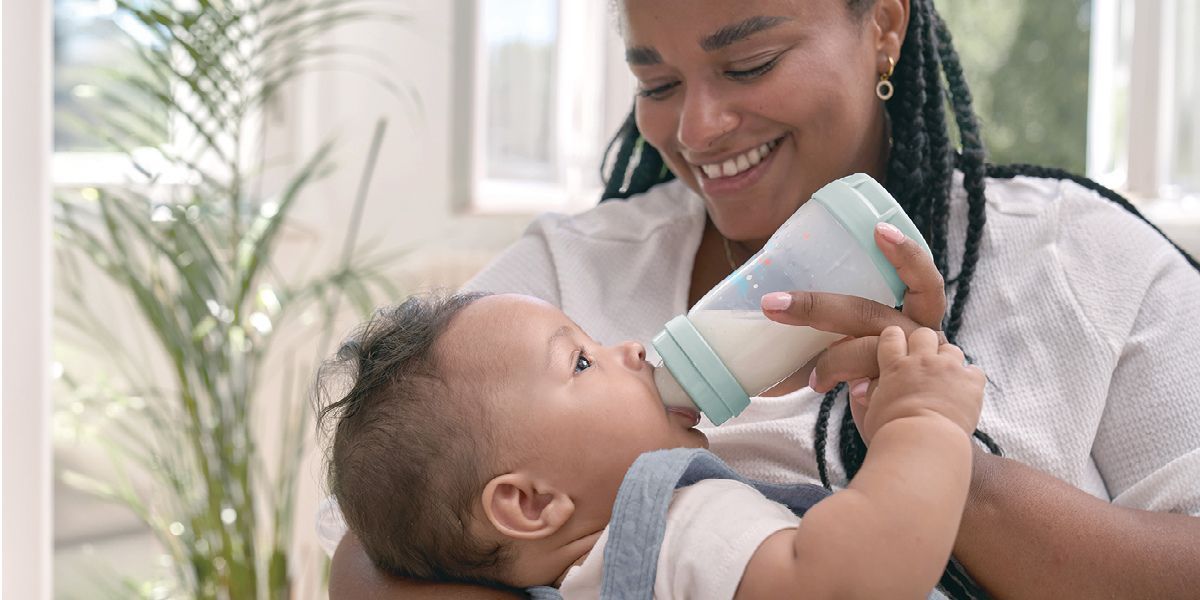Bottles & Cups
The MAM bottle is unscrewed and taken apart to make it easier to clean. This makes it easy to rinse the individual parts with water and a mild cleaning agent. All individual parts become hygienically clean in any steriliser. Sterilisation before each use of the bottle is particularly important for newborns.
The body’s defences are already very well developed in a baby who is 12 months old. At this age, all you need to do is sterilise the bottle and the teat occasionally. If the baby is ill, the bottle should be sterilised again every single day.
Self-Sterilising
- The self-sterilising feature of the Easy Start™ Bottle is proven to be effective for killing common household germs and bacteria. For the best results, please follow all instructions carefully.
- Clean thoroughly as instructed above before self-sterilising.
- After cleaning, assemble bottle parts in the following way: base with with silicone valve, teat with screw ring/collar, bottle body and lid.

Step 1: Using the scale on the bottle lid, measure 20ml of tap water and pour this into the base (with white valve)
Step 2: Place the screw ring/collar with teat on the bottle base with water. Place and rest the bottle body over this. (DO NOT SCREW DOWN).
Step 3: Place the lid on top - your bottle is now ready for self-sterilising. Set your microwave timer according to how many bottles you are simultaneously cleaning. Set microwave from 500 to 1000 Watts.

- After self-sterilising allow bottle to cool down before removing from microwave.
- Recommended cooling time at least 10 minutes with opened microwave door. Be careful to hold the base and keep the bottle straight when removing from the microwave to avoid spilling any left over hot water.
- After the process is complete, if the bottle is left as assembled in step 3, it will remain disinfected for up to 48 hours. When self-sterilising on the go, you should self-sterilise, assemble your bottle and make up your feed straight after self-sterilising.
- After cooling time and using the bottle straight away: remove from the microwave and pour away any leftover water carefully. Shake parts to remove excess water.
- When Assembling do not worry about some water remaining on the bottle parts, this has been disinfected.
- Follow the user manual instructions for your microwave/device.
- Ensure that all parts from the self-sterilising bottle and microwave (including waveguide cover and turntable) are COMPLETELY clean and free from dirt, food residue, fat or oil splashes. If not this could lead to the product melting, the microwave sparking or the waveguide cover burning!
- The self-sterilising bottle should always be placed on the outer sides of the turn plate, and not in the centre of the plate as this could result in uneven heat distribution for disinfection.
- Do not leave your microwave unattended during the sterilising process.
- Never self-sterilise your bottle without water or incorrect water level; please be sure to use exactly 20mls of tap water.
- Always set the microwave to the correct power and time. If using a combination microwave, ensure the bottle is not exposed to the heat of the grill because this will damage it.
Before the bottle is placed in the water bath or the bottle warmer, the teat and cap must always be removed. The contents of the bottle must not boil – so do not pour any boiling liquids into it!
Before feeding begins, the bottle should be dried using a clean cloth.
NHS do not recommend warming in a microwave as this can
cause hot spots in the milk.
After heating milk, stir thoroughly or gently shake to evenly
distribute the heat. Always check feeding temperature before
giving this to your baby. NEVER heat the bottle with food in it
above 70°C.
For hygiene reasons, the teats should be replaced at regular intervals. Simply check the teat each time you are about to use the bottle – especially when baby already has teeth – and replace it when the first signs of damage or weak points become apparent.
Yes, because the innovative protective cap ensures that the liquid remains in the bottle. This means there is no need for any small sealing disc: Simply place the protective cap on the bottle and then you can transport it safely.
Yes, all parts in the MAM bottles are shatterproof, except the Glass bottle as glass may break.
Four-month-old babies love drinking from a cup. The MAM Cup range provides them with the ideal support here. This will ensure that baby makes the perfect transition from breastfeeding or bottle feeding to independent drinking.
No. MAM products do not contain any plasticizers.
MAM only ever uses materials which satisfy the highest demands and safety standards. This means that MAM products guarantee that babies enjoy the best start in life.
- Do not screw any parts of the bottle together when self-sterilising/sterilising
- Wait at least 10 minutes after sterilising, before reassembling the bottle to make up a feed
- Do not pour boiling water in the bottle
- Never prepare a bottle whilst holding a baby/with baby present
Please read full instructio leaflet before use and for more information please visit our guide on how to prepare a baby bottle
Bottle teat
MAM has developed bottle teats in five different sizes. This means that the size of the holes is always perfectly matched to the stage of your babies development.
Five smart sizes for perfect enjoyment while sucking:
Size 0: Extra small for newborns - ideal for breastmilk & formula
Size 1: from birth onwards – for baby’s first food which is particularly free-flowing
Size 2: from 2 months – perfect for the baby who is now slightly better trained
Size 3: from 4 months – baby sucks more vigorously and drinks faster
Size x: from 6 months – ideal for thick liquids

Bottle teats are simply rinsed with water and mild cleaning agent or cleaned in the upper compartment of the dishwasher.
The teat is sterilised before it is first used and then at regular intervals.
For hygiene reasons, the teats should be replaced at regular intervals. Simply check the teat each time you are about to use the bottle – especially when baby already has teeth – and replace it when the first signs of damage or weak points become apparent.
The MAM Teat is easily accepted by 94%* of babies thanks to its SkinSoft™ silicone surface and its unique flat shape, which feel so familiar to babies. This facilitates a switching between breast- and bottlefeeding.
(*Market research 2009-2023, tested with 1808 babies)
MAM Drinking Cups
Yes. Thanks to their patented valve, the MAM drinking cups always remain leak-tight when they should. At the same time, babies can drink from them with ease.
However, after drinking a few residual drops may still be left in the drinking spout. If the child shakes the cup forcibly, this small residual amount of liquid may escape – but no more liquid than this will.
Fizzy drinks are not recommended. They impair the leakproofness of the cup. Do not pour any hot liquids (over 40°C) into the drinking cup!
All components of the smart Learn to Drink Cups can be cleaned very easily: Either with water, mild cleaning agent and a soft sponge or in the top compartment of the dishwasher. In the dishwasher, the patented valve with the small hole is fixed on one of the bars.
Individual components in the MAM drinking cups can be discoloured by food.
Yes, all MAM drinking cups are made from shatterproof materials.


